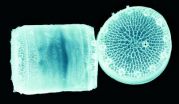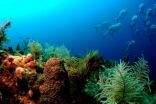(Press-News.org) SEQUIM, Wash. – A glow coming from the glassy shell of microscopic marine algae called diatoms could someday help us detect chemicals and other substances in water samples. And the fact that this diatom can glow in response to an external substance could also help researchers develop a variety of new, diatom-inspired nanomaterials that could solve problems in sensing, catalysis and environmental remediation.
Fluorescence is the key characteristic of a new biosensor developed by researchers at the Department of Energy's Pacific Northwest National Laboratory. The biosensor, described in a paper published this week in the scientific journal PLoS ONE, includes fluorescent proteins embedded in a diatom shell that alter their glow when they are exposed to a particular substance.
"Like tiny glass sculptures, the diverse silica shells of diatoms have long intrigued scientists," said lead author and molecular biologist Kate Marshall, who works out of PNNL's Marine Sciences Laboratory in Sequim, Wash. "And the way our biosensor works could make diatoms even more attractive to scientists because it could pave the way for the development of novel, synthetic silica materials."
Diatoms are perhaps best known as the tiny algae that make up the bulk of phytoplankton, the plant base of the marine food chain that feeds the ocean's creatures. But materials scientists are fascinated by diatoms for another reason: the intricate, highly-ordered patterns that make up their microscopic shells, which are mostly made of silica. Researchers are looking at these minuscule glass cages to solve problems in a number of areas, including sensing, catalysis and environmental remediation.
PNNL Laboratory Fellow and corresponding author Guri Roesijadi found inspiration for this biosensor in previous work by other researchers, who showed it's possible to insert proteins in diatom shells through genetic engineering. Using that work as a starting point, Roesijadi, Marshall and their PNNL colleagues aimed to use fluorescent proteins to turn diatoms into a biosensor. They specifically aimed to create a reagent-less biosensor, meaning one that detects a target substance on its own and without depending on another chemical or substance.
Well-equipped diatom
As a test case, the PNNL team inserted genes for their biosensor into Thalassiosira pseudonana, a well-studied marine diatom whose shell resembles a hatbox. The new genes allowed the diatoms to produce a protein that is the biosensor.
At the heart of the biosensor is the ribose-binding protein, which, as the name suggests, attaches to the sugar ribose. Each ribose-binding protein is then flanked by two other proteins – one that glows blue and another that glows yellow. This three-protein complex attaches to the silica shell while the diatom grows.
In the absence of ribose, the two fluorescent proteins sit close to one another. They're close enough that the energy in the blue protein's fluorescence is easily handed off, or transferred, to the neighboring yellow protein. This process, called fluorescence resonance energy transfer, or FRET, is akin to the blue protein shining a flashlight at the yellow protein, which then glows yellow.
But when ribose binds to the diatom, the ribose-binding protein changes its shape. This moves the blue and yellow fluorescent proteins apart in the process, and the amount of light energy that the blue protein shines on the yellow protein declines. This causes the biosensor to display more blue light.
Microscopic light show
Regardless of whether or not ribose is bound to the diatom's biosensor, the biosensor always emits some blue or yellow glow when it's exposed to energy under a microscope. But the key difference is how much of each kind of light is displayed.
The PNNL team distinguished between light from the two proteins with a fluorescence microscope that was equipped with a photon sensor. The sensor allowed them to measure the intensities of the unique wavelengths of light given off by each of the fluorescent proteins. By calculating the ratio of the two wavelengths, they could determine if the diatom biosensor was exposed to ribose, and how much of ribose was present.
The team also succeeded in making the biosensor work with the shell alone, after it was removed from the living diatom. Removing the living diatom provides researchers greater flexibility in how and where the silica biosensor can be used. The Office of Naval Research, which funded the research, believes biosensors based on modifying a diatom's silica shell may prove useful for detecting threats such as explosives in the marine environment.
"With this research, we've made our important first steps to show it's possible to genetically engineer
organisms such as diatoms to create advanced materials for numerous applications," Marshall said.
INFORMATION:
Co-authors on the paper include scientists at EMSL, DOE's Environmental Molecular Sciences Laboratory at PNNL's Richland, Wash., campus. They used EMSL's mass spectrometry capabilities to verify the team had the correct ribose-binding and fluorescent proteins before adding them to the diatoms.
REFERENCE: Kathryn E. Marshall, Errol W. Robinson, Shawna M. Hengel, Liljana Pasa-Tolic, Guritno Roesijadi, "FRET Imaging of Diatoms Expressing a Biosilica-Localized Ribose Sensor," PLoS ONE, March 21, 2012, DOI: 10.1371/journal.pone.0033771, http://dx.plos.org/10.1371/journal.pone.0033771.
Interdisciplinary teams at Pacific Northwest National Laboratory address many of America's most pressing issues in energy, the environment and national security through advances in basic and applied science. PNNL employs 4,700 staff, has an annual budget of nearly $1.1 billion, and has been managed for the U.S. Department of Energy by Ohio-based Battelle since the laboratory's inception in 1965. For more, visit the PNNL's News Center, or follow PNNL on Facebook, LinkedIn and Twitter.
EMSL, the Environmental Molecular Sciences Laboratory, is a national scientific user facility sponsored by the Department of Energy's Office of Science. Located at Pacific Northwest National Laboratory in Richland, Wash., EMSL offers an open, collaborative environment for scientific discovery to researchers around the world. Its integrated computational and experimental resources enable researchers to realize important scientific insights and create new technologies. Follow EMSL on Facebook, LinkedIn and Twitter.
Diatom biosensor could shine light on future nanomaterials
Discovery could lead to new methods for environmental remediation and speeding up chemical reactions
2012-03-26
ELSE PRESS RELEASES FROM THIS DATE:
Ancient civilizations reveal ways to manage fisheries for sustainability
2012-03-26
In the search for sustainability of the ocean's fisheries, solutions can be found in a surprising place: the ancient past.
In a study published on March 23 in the journal Fish and Fisheries, a team of marine scientists reconstructed fisheries yields over seven centuries of human habitation in Hawaii and the Florida Keys, the largest coral reef ecosystems in the United States, and evaluated the management strategies associated with periods of sustainability. The results surprised them.
"Before European contact, Native Hawaiians were catching fish at rates that far ...
Adner Colon Attend Exclusive Action Freedom Legacy Mastermind Event at Hasbrouck Heights, NJ
2012-03-26
Online Marketing Entrepreneur Adner Colon knew his life would change when he joined Carbon Copy Pro in February 2012 but not in the way he expected.
Online Marketing Entrepreneur Adner Colon knew his life would change when he joined Carbon Copy Pro in February 2012 but not in the way he expected.
On March 24th and 25th Adner Colon will be attending an exclusive Action Freedom Legacy (AFL) Legacy Mastermind event at Hasbrouck Heights. The trainers for the event are Aaron and Sophia Raskin and members of the Loyal 9 who are top producers in the online marketing industry.
Here's ...
Low serum adiponectin levels predict future risk for asthma in women
2012-03-26
Low serum adiponectin levels predict an increased future risk for developing asthma in middle-aged women, particularly among smokers, according to a new study.
"Adiposity is known to be related to asthma. Although a causal link between adiponectin (a protein produced by adipose tissue) and asthma has been demonstrated in mice, the evidence in humans has been conflicting," said lead author Akshay Sood, MD, MPH, associate professor in the Division of Pulmonary and Critical Care Medicine at the University of New Mexico Health Sciences Center School of Medicine.
"In an ...
Periodontal therapy reduces hospitalizations and medical care costs in diabetics
2012-03-26
Tampa, Fla., USA – Today, during the 41st Annual Meeting & Exhibition of the American Association for Dental Research (AADR), held in conjunction with the 36th Annual Meeting of the Canadian Association for Dental Research, an abstract titled "Periodontal Therapy Reduces Hospitalizations and Medical Care Costs in Diabetics" to determine if periodontal treatment was associated with the number of hospitalizations and cost of medical care among diabetics with periodontal disease.
A longitudinal study compared medical costs for diabetic subjects with periodontal disease ...
Study: Preoperative estrogen-blocking therapy may preempt need for mastectomy
2012-03-26
Orlando – March 23, 2012. Preoperative treatment with aromatase inhibitors increases the likelihood that postmenopausal women with estrogen receptor-positive breast cancer will be able to have breast-conserving surgery rather than a mastectomy, according to the results of a national clinical trial presented today at the Society of Surgical Oncology annual meeting in Orlando, Fla.
"We found that half of the postmenopausal women in the study who initially faced having a mastectomy were able to have breast-conserving surgery after being treated for four months with an aromatase ...
New epilepsy gene located in dogs
2012-03-26
A new epilepsy gene for idiopathic epilepsy in Belgian Shepherds has been found in the canine chromosome 37. The research of Professor Hannes Lohi and his group conducted at the University of Helsinki and the Folkhälsan Research Center opens new avenues for the understanding of the genetic background of the most common canine epilepsies. The research also has an impact on the understanding of common epilepsies in humans. The research is published in the scientific journal PLoS ONE on March 23, 2012.
Epilepsy affects about 1-5% of the human population at some stage of ...
Overweight and obese women at greater risk of breast cancer recurrence
2012-03-26
Vienna, Austria: Women who are overweight or obese when they are diagnosed with breast cancer are at higher risk of cancer recurrence or related death than are leaner women, according to a new study to be presented to the 8th European Breast Cancer Conference (EBCC-8) today (Friday). This finding held true even though the study mandated that chemotherapy dosage be adjusted for body weight, and adds further to the evidence that lifestyle factors can influence cancer prognosis, a researcher will tell the conference.
Dr. Jennifer Ligibel, a medical oncologist at the Dana-Farber ...
Mike Hoesly Attends Legacy Mastermind
2012-03-26
On March 24, 2012 Mike Hoesly attended the Legacy Mastermind in Hasbrouck Heights, NJ. The mastermind is a group of 20 internet marketers getting together to share industry secrets and tips of the trade. The Loyal 9 Revolution and Team Rashkin are leading the event. These two groups have dominated the home business industry for the past few years drawing in hundreds of thousands of leads and millions of dollars as a result.
Hoesly has attended many live events in the industry and the skills learned here will only add to his repertoire. Hoesly says," Live events ...
Ultrasound-guided surgery is best way to remove breast tumours
2012-03-26
Vienna, Austria: The use of ultrasound-guided surgery to remove tumours from women who have palpable breast cancer is much more successful than standard surgery in excising all the cancerous tissue while sparing as much healthy tissue as possible, according to the results of a randomised controlled trial.
As a consequence, researchers told the eighth European Breast Cancer Conference (EBCC-8) today (Friday) they expect their findings will change surgical practice and ultrasound-guided surgery (USS) should become the norm for excising palpable tumours i.e. those that can ...
Highly flexible despite hard-wiring -- even slight stimuli change the information flow in the brain
2012-03-26
One cup or two faces? What we believe we see in one of the most famous optical illusions changes in a split second; and so does the path that the information takes in the brain. In a new theoretical study, scientists of the Max Planck Institute for Dynamics and Self-Organization, the Bernstein Center Göttingen and the German Primate Center now show how this is possible without changing the cellular links of the network. The direction of information flow changes, depending on the time pattern of communication between brain areas. This reorganisation can be triggered even ...
LAST 30 PRESS RELEASES:
A new kind of copper from the research reactor
Making simulations more accurate than ever with deep learning
Better predicting the lifespan of clean energy equipment, towards a more efficient design
Five ways microplastics may harm your brain
Antibody halts triple-negative breast cancer in preclinical models
Planned birth at term reduces pre-eclampsia in those at high risk
Penguins starved to death en masse, study warns, as some populations off South Africa estimated to have fallen 95% in just eight years
New research explains how our brains store and change memories
Space shuttle lessons: Backtracks can create breakthroughs
New study finds cystic fibrosis drug allows patients to safely scale back lung therapies
From field to lab: Rice study reveals how people with vision loss judge approaching vehicles
Study highlights underrecognized link between kidney disease and cognitive decline
Researchers find link between psychosocial stress and early signs of heart inflammation in women
Research spotlight: How long-acting injectable treatment could transform care for postpartum women with HIV
Preempting a flesh-eating fly’s return to California
Software platform helps users find the best hearing protection
Clean hydrogen breakthrough: Chemical lopping technology with Dr. Muhammad Aziz (full webinar)
Understanding emerges: MBL scientists visualize the creation of condensates
Discovery could give investigators a new tool in death investigations
Ultrasonic pest control to protect beehives
PFAS mixture disrupts normal placental development which is important for a healthy pregnancy
How sound moves on Mars
Increasing plant diversity in agricultural grasslands boosts yields, reducing reliance on fertilizer
Scientists uncover a new role for DNA loops in repairing genetic damage
AI chatbots can effectively sway voters – in either direction
Study reveals 'levers' driving the political persuasiveness of AI chatbots
'Tiny' tyrannosaurid, Nanotyrannus lancensis, was a distinctive species, not juvenile T. Rex
Scientists capture first detailed look inside droplet-like structures of compacted DNA
Return of the short (tyrant) king: A new paper by Dinosaur Institute researcher shows Nanotyrannus was not a juvenile T. Rex
New study confirms Nanotyrannus holotype was distinct species from T. rex
[Press-News.org] Diatom biosensor could shine light on future nanomaterialsDiscovery could lead to new methods for environmental remediation and speeding up chemical reactions




